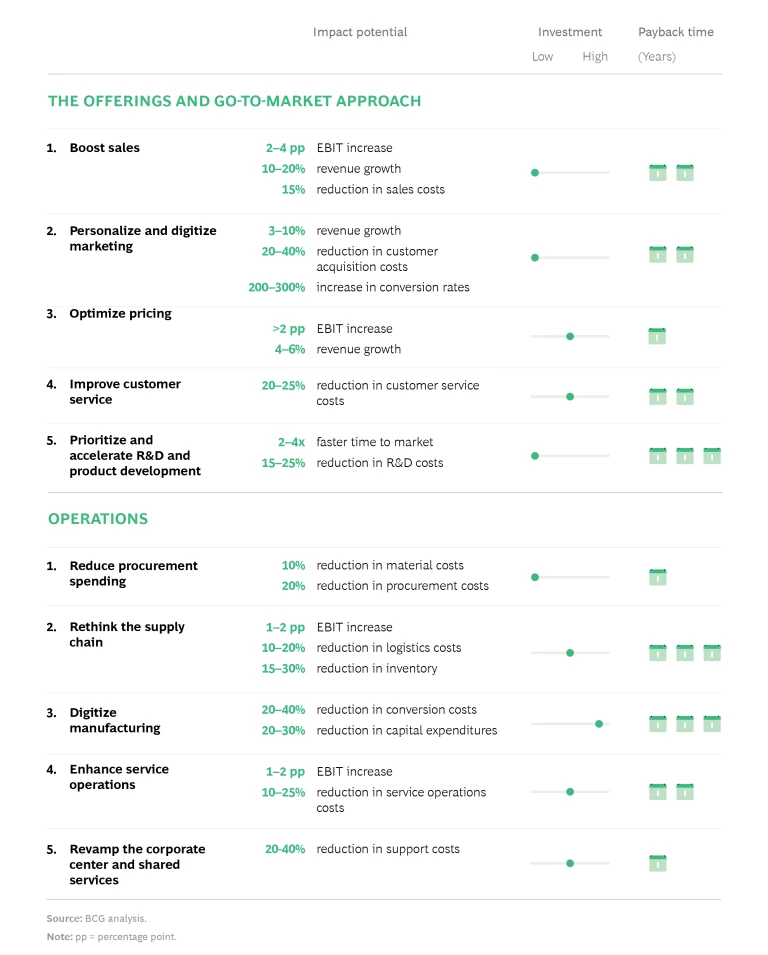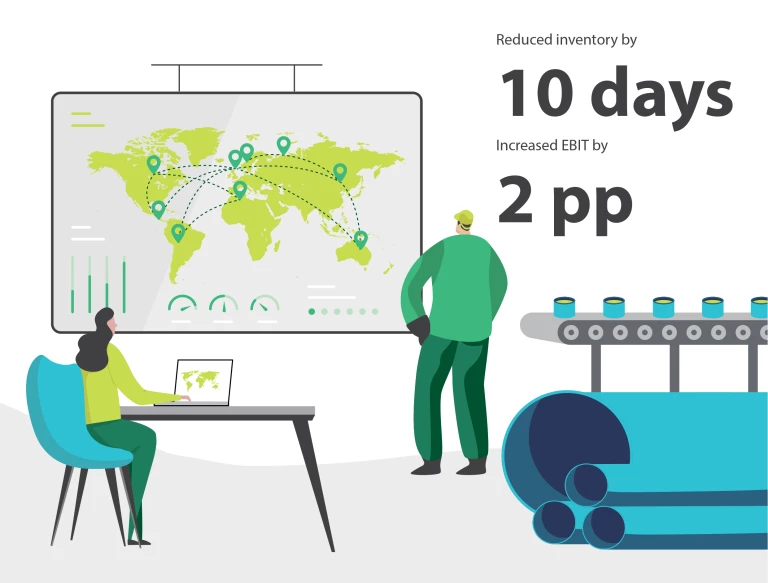You may have experienced something like this: Your company launches a major improvement initiative, with steep cost reduction targets. Thanks to a lot of hard work, the company hits those goals, yet two years later costs are right back where they were before the effort began—if not higher.
The pressure on management teams to improve company performance keeps growing, from activist investors, market disruptions, and new types of competition. To help meet these challenges, we have identified a set of digital measures that can lead to rapid and sustainable upgrades in performance by reducing costs and raising revenue and profit margins. These are not exploratory, high-risk initiatives—rather, they have been tested across a variety of industries and proved their ability to boost performance quickly.
We recently analyzed several dozen organizations across an array of industries and geographic areas, speaking to case teams and company leaders. Our goal was to synthesize that experience and identify the areas and improvement levers that are most conducive to rapid performance enhancements using digital. Specifically, our analysis highlighted ten areas that should be priorities for virtually all organizations.
For companies that have already captured the gains from traditional improvement levers such as cutting costs, implementing digital can help them reach the next level of performance. And for companies that haven’t yet begun the process, these measures should be an integral part of an improvement program. They can deliver tangible, real-world results and help companies build the data and analytical capabilities they need to compete.
Digital Can Deliver Fast, Sustainable Gains
Digital and data initiatives can help companies make lasting improvements that don’t disappear once the transformation is over, primarily because they lead to new ways of working. Rather than just cutting costs and asking teams to execute existing processes with fewer people, digital tools allow leaders to redesign processes from the ground up. The processes are automated, with data captured at the right junctures to deliver insights to managers. For this reason, digital measures rewire organizations to perform better—not through a one-time change but through a fundamental reboot of how work gets done.
Digital measures rewire organizations to perform better—not through a one-time change but through a fundamental reboot of how work gets done.
That said, it’s easy to get overwhelmed by digital, particularly for companies that have long-entrenched histories and ways of working. Often, the hardest part is simply knowing how and where to start. To make sense of the digital landscape for leaders, we identified the market-tested measures that are most applicable to the widest range of organizations. That analysis points to ten initiatives, in two broad areas (see the exhibit):
- Product and service offerings, including the go-to-market approach
- Operations
The Product Offering and Go-to-Market Approach
The first core area is the use of digital tools to improve the way a company develops and sells its products and services—and even to improve what it sells. The objective is speed, though, so most of these measures focus on commercial areas, rather than making fundamental changes to the product and service offerings.
1. Boost sales. In our experience, using digital can lead to a major improvement in sales performance for B2B companies. Consider that half of B2B buyers are millennials (who expect a dramatically different customer journey) and that the average buyer is 60% of the way through the purchase process before interacting with a sales rep. By empowering the field sales force and their managers with digital tools—such as mobile apps linked to the organization’s CRM platform—companies can more accurately segment customers and allow sales reps to focus their time and resources on the highest-probability targets.
Similarly, organizations can use digital and data to boost the performance of their inside sales teams, by cost-effectively reaching customers who have been overlooked with traditional approaches. And although e-commerce is an obvious avenue for growth, many B2B companies fail to pursue it effectively owing to operational constraints, such as rigid legacy IT infrastructure, and a lack of ambition. Digital can help companies to overcome those obstacles.
In our experience, companies that digitize their B2B sales can generate gains of 10% to 20% in revenue, improve marketing efficiency by 15% to 30% (in areas such as reduced cost per lead), boost their digital ROI by 20% to 50%, and triple their conversion rates across the entire customer journey.
With digital marketing, organizations can spend less without any decrease in reach—in some cases even expanding their reach.
2. Personalize and digitize marketing. Traditional marketing can be imprecise, challenging to measure, and wasteful. Digital marketing is far more targeted and personalized, leading to a better customer experience. By using digital, companies can capture customer feedback through inputs such as shopping and browsing behavior and preferences, social media, and other channels and then use that data to tailor more effective marketing messages. As a result, organizations can spend less without any decrease in reach—in some cases even expanding their reach.
For example, one global retailer launched a very fast initiative to improve marketing. It put its existing data on a cloud infrastructure and used digital to deliver segmented offers across channels, leading to a tripling of marketing-campaign results, a doubling in the response rate to marketing, and a $100 million increase in net incremental revenue.
Similarly, a leading European fashion retailer adopted a more comprehensive digital approach to marketing. In response to a sharp decline in like-for-like sales, the company launched a transformation program to become best in class at digital marketing and personalization. To improve short-term performance, the company applied a data-driven approach to reallocate media spending and increased its spending in the most effective channels and markets. That initiative generated a double-digit increase in like-for-like sales, producing a high return on investment for the project.
To win in the medium term, the company launched an agile test-and-learn approach with digital marketing pilots that used customer data to create more relevant, personalized experiences across digital channels. Within five months, the pilots delivered a boost of 20% to 40% in conversion rates, and the company decided to scale the initiatives across a broader segment of its marketing spending. Within a year, the company increased its return on marketing spending for those categories by about 40%. Just as important, the company is now systematically leveraging data to steer all marketing decisions, putting it on track to achieve its ambition of becoming an industry leader in digital marketing.
3. Optimize pricing. Many commercial functions still set prices on the basis of gut instinct or what they charged last year. By using progressive pricing (which ties the price of a given product or service to the value a customer receives from it), companies can ensure that they have the right offering, format, and price for every customer, purchasing occasion, and channel and can allocate their resources proactively to tap into future profit growth. Top-performing organizations also use demographic, geospatial, and loyalty data to model actual price perceptions and optimize their pricing and assortment. For example, one US retailer generated a $5 million boost in revenue in just a single product category through more intelligent, data-driven pricing.
Similarly, organizations (particularly in retail) can use data to improve the effectiveness of promotions and markdowns. For a typical fashion brand, end-of-season sales can account for up to 50% of annual revenue. Using analytics-driven prediction models, companies can improve markdowns by applying the right discount to the right product and targeting a promotion to the right customer on the basis of his or her profile. Over time, organizations can learn from experience in order to better understand how price elasticity changes for given product categories on a weekly basis and can adjust the prediction models to become more accurate. By using this approach, one retail organization saw a 7% increase in margins through more targeted promotions and an 18% increase in margins from improved markdowns.
Companies can use digital to optimally allocate resources such as call center staff, leading to a better customer experience.
4. Improve customer service. Digital technologies are transforming the way that companies interact with and serve their customers. For simple customer problems, companies can set up digital self-serve chatbots that are empowered by AI and machine learning, allowing customers to rapidly solve their own problems without the need for human support. For more advanced problems, companies can use digital to optimally allocate resources such as call center staff, leading to a better customer experience. Over time, companies can harness the data from these exchanges to refine their customer communications, manuals, and other interactions.
For example, an airline delivered a superlative in-flight experience but struggled with its customer service on the ground. Call wait times were too long, and customers didn’t have any self-serve options. Worse, the company had no systematic means to gather and analyze the data from these interactions in order to spot the underlying problems and build a richer understanding of individual customers. To improve, the company implemented a set of digital tools. It developed a chatbot for the easiest customer questions related to offers and promotions and redesigned its marketing communications to actively push customers to the chatbot channel. As a result, it reduced in-person volume for this type of query by 80%. Perhaps more important, the airline increased its customer satisfaction ratings by 5 percentage points.
5. Prioritize and accelerate product development. The final priority in the first area—the product and service offerings and go-to-market approach—is to improve and speed up new-product development. More specifically, companies can pull customer data, preferences, and pain points from sales and marketing interactions, field sensors, and other inputs and integrate that information more directly into the R&D process, to prioritize what customers want and are willing to pay for. They can also improve product features rapidly with usage data automatically reported by the product.
Internally, digital tools allow companies to prototype new offerings virtually, reducing the need for costly physical prototypes and cutting testing time by more than half. Collectively, these measures can decrease the time to market by up to 70% and reduce the failure of products in development by as much as 20%.
Operations
The second core area for digital tools is operations. As with the first area, we identified five of the most promising tools and applications in use by companies today.
1. Reduce procurement spending. The typical organization buys hundreds of thousands of products and services, from a sprawling network of suppliers, yet rarely has the ability to control purchasing throughout the company. Digital tools such as analytics allow companies to better understand their procurement and tailor the right improvement approach in order to maximize the impact across the full supplier network.
For example, many companies have succeeded by aggregating all purchasing data and grouping their suppliers into three categories.
The companies take a comprehensive approach to the largest 20 to 40 suppliers, with a collaboration that offers lower prices to the purchaser and increased margins to the supplier. Because this universe of suppliers is relatively small, companies can tailor their approach down to the level of individual suppliers and elevate their negotiations to the level of supplier CEOs.
The second tier includes the next 100 to 200 suppliers, and improvement measures are based more on an assessment of relative power between the purchaser and the supplier. In many cases, AI systems can analyze this power and suggest a specific negotiating strategy for purchasing managers.
The third and final tier includes “long tail” suppliers—the network of businesses that sell goods and services to the company in smaller volumes. These suppliers tend to be far more fragmented across categories and geographic markets, making it hard for procurement organizations to get a clear sense of their spending on these supplies or how they can improve. Using AI and advanced analytics, companies can gain clarity about incremental price reductions that add up across a large number of suppliers.
An Australian retail bank had tail spending of approximately $240 million across some 30,000 suppliers, and most of that was not formally addressed through the company’s procurement function. The bank combined and cleaned several data sets to create a single source of truth and ran advanced analytics to group that spending into categories and visualize the results. On the basis of insights from that process, the bank captured savings by better managing internal demand, eliminating some suppliers and consolidating others, and negotiating more effectively with the remaining suppliers. The company also used the findings from the analysis to update procurement policies and systems and established a mechanism to use the database for ongoing monitoring and reporting, to make sure that all gains would be sustainable.
The savings from using digital in procurement can be dramatic: a reduction of up to 10% of costs for some materials and as much as 20% for long-tail supplies.
In the aggregate, the savings from using digital processes and tools in procurement can be dramatic: a reduction of up to 10% of costs for some materials and as much as 20% for long-tail supplies that the company orders less frequently or in lower volumes.
Other companies use an AI algorithm to coach managers to select the optimal negotiation tools for working with individual suppliers. The tool analyzes the factors driving a specific commercial decision and uses game theory to identify the strongest tools—such as a type of auction or tender process, along with commercial aspects such as different type of commercial optimizations. It also learns from previous negotiations and incorporates changes in the commercial environment to improve its accuracy over time. One organization that implemented the AI coach generated a 5% drop in spending and freed up 30% of managers’ time by simplifying the negotiation process.
2. Rethink the supply chain. As supply chains become more complex, far-reaching, and interconnected, traditional means of managing them are falling short. In contrast, companies that use digital supply chain tools can create greater visibility and predictability across the entire network and thus enable operations executives to make smarter decisions. For example, some basic processes and even decisions can be automated in ways that optimize inventories and improve the accuracy of plans and forecasts. By better predicting demand changes and materials shortfalls and using analytics to mitigate the impact of issues before they happen, companies can increase fulfillment rates.
In addition, organizations can use digital tools and big data to optimize their supply networks. Compared with other levers discussed in this publication, this initiative often takes longer to implement, for two reasons. First, data and systems are fragmented in many cases, requiring that companies develop tailor-made solutions that can aggregate information from legacy systems. Second, modifying the network typically requires changing a large number of physical assets and contracts, which takes time.
That said, if the process takes a bit longer than the other measures discussed here, the results are just as significant. Companies that leverage digital and big data to optimize their supply chains can boost the amount of demand they can meet by up to 6%, even as they reduce costs by as much as 20% in manufacturing, warehousing, and distribution. In addition, smarter inventory management can free up 15% to 30% of working capital.
Companies can also use “digital twins,” or virtual models of their supply chain, to test various hypotheses about how to improve before they make real-world changes to physical assets. For example, a global medtech company developed a digital twin of its supply chain. The company used analytics to better understand its current situation—along with variations in supply and demand—and rebalance inventory across its manufacturing and distribution network, leading to a 20% reduction in inventory throughout the entire supply chain.
In another example, a European steel producer developed a digital twin of its supply chain, mapping and simulating distribution and manufacturing assets and using machine-learning algorithms to forecast demand and production capacity. The company created a data lake that could pull data from 60 sources into a single system, far faster than traditional IT infrastructure. By using this information to make smarter sales and operational-planning decisions, the company reduced inventory by more than ten days of sales and increased EBIT by more than 2 percentage points.
3. Digitize manufacturing. According to BCG research, managers see the largest opportunities for operations improvement with digital in the manufacturing area. As with supply chain digitization, however, the process requires an investment of capital and time because it often entails changes to physical assets. While some organizations opt to completely redesign their production facilities with AI and other advanced applications, others apply more targeted measures that unlock value more quickly.
Managers see the largest opportunities for operations improvement with digital in the manufacturing area.
For example, smart analytics can sort through existing manufacturing data to help companies rapidly reduce the downtime of production equipment and make maintenance operations more value based and efficient. In addition, by using automation, sensors, and predictive algorithms in quality control—a labor-intensive aspect of manufacturing—companies can improve quality at lower costs.
In fact, our experience shows that organizations can reduce manufacturing costs by up to 20% while reducing defect rates by as much 90% and working capital by up to 30%.
As with supply chain improvements, companies can use digital twins to gauge the impact of potential manufacturing initiatives before making actual changes. The process is far less costly than the traditional approach to improving manufacturing, which often triggers unintended consequences.
For example, an industrial company used a digital twin to improve its milling processes. It used historical production data to build a virtual model of its mill and then fed two years of operational data on 400 different variables into the model. The company tested different hypotheses for improvement before determining which would lead to the best outcome. At that point, it made the physical changes necessary, resulting in a 1.5% increase in efficiency for the mill.
4. Enhance service operations. For most manufacturers, aftermarket service is a large and growing business opportunity. Top OEMs generate roughly a third of revenue—and half of gross margins, or more—from their service businesses, which are growing faster than the market for new equipment.
By using digital tools, companies can boost the performance of their service operations and transform customer interactions. For example, more granular customer data can help companies segment customers during the initial purchase transaction, in order to understand which customers are likely to need—and purchase—service plans. Companies can also use data-driven insights to develop new service models, as a means of differentiating themselves in the market. For instance, embedding sensors into new equipment can give customers advance notice about potential maintenance issues so that companies can proactively maintain equipment and thus avoid downtime.
And when repairs are required, digital tools can help improve the performance of field technicians by ensuring that they have the right information and parts for a given repair. Companies can reduce the number of technicians by up to 20% and still meet the same demand while delivering better customer service (such as on-time arrival at job sites, with technicians who have the right tools and parts for a given job request).
5. Revamp the corporate center and shared services. Traditional shared services employ large numbers of people in countries with low labor costs, where they execute mostly manual, repetitive processes. But that can be expensive, inefficient, and error prone. To improve, companies are digitizing their support functions, using tools such as robotic process automation (RPA), machine vision, and AI to handle many of those tasks, reducing costs, increasing accuracy, and freeing people for more value-added work.
For example, in the finance function, digital tools are available that can automate processes like accounts payable, handling invoices and payment approvals with no oversight (even nonstandard invoices) and extracting and synthesizing data from employees’ travel and expense claims.
In HR, these tools can support workforce planning by tracking staff changes and identifying emerging issues. They can automate the process of scanning resumes and creating shortlists of candidates, set up the documentation and communications for new hires, and even offer on-the-job coaching.
In the early stages, companies can digitize existing processes, but over time, they unlock greater gains by redesigning the processes to capitalize on the advantages of digital tools. That kind of process redesign often centers on reducing the pain points of internal customers for shared services—business units and employees—ultimately leading to a better experience for those users.
Sizable value is at stake. Implementing RPA, AI, and related tools can lead to head count reductions of 20% to 30%, with even greater cost cuts of up to 40%. Critically, digital can also lead to dramatic improvements in service quality—for example, faster handling of processes, more accessible services for employees, and increased accuracy.
Management teams often don’t quite know how to get started with digital, and they underestimate the urgency.
How to Start Today
From our experience helping companies use digital to generate rapid performance improvements, we find that management teams often don’t quite know how to get started, and they underestimate the urgency. Sometimes, they are fully occupied running the business day-to-day, and digital lies outside their area of expertise. For those leaders, we offer some steps to begin capitalizing on digital:
- Understand your company’s level of digital maturity. A systematic assessment can establish a baseline for the organization and ensure that you are setting the right level of ambition—pushing for change while still being realistic about what is possible.
- Identify the performance improvement potential from applying these digital measures across the organization.
- Prioritize areas of improvement and digital levers according to the amount of time needed to implement them and the potential value they can generate. Early success with the fastest and highest-impact measures can create momentum and unlock capital. After those quick wins, management can turn to more complex measures that will bring additional successes in the medium term.
Five Principles to Implementing Change Through Digital
For most organizations, change programs can be stressful and complex, regardless of whether they are full-scale transformations or more targeted initiatives. But in addition to using digital to improve performance, companies can use the same approach to manage performance improvement programs themselves. Digital gives leaders greater transparency over what’s needed, which measures should be prioritized, and how the company’s efforts are proceeding.
Here are five key principles for using digital to implement change throughout the organization.
- Use digital to track execution. Current applications can help leaders manage large-scale change in a volatile business environment, giving them greater transparency about the overall status of the program. Some companies have created digital impact centers—physical rooms that serve as the nerve center of a comprehensive program, equipped with multiple screens that show real-time data on its progress, along with any looming problems. Similarly, mobile apps allow program leaders to communicate with managers and frontline employees and solicit feedback.
- Prioritize among digital projects. Companies often have dozens, or hundreds, of digital initiatives underway, leading to confusion and wasted resources. Digital tracking tools can help segment the portfolio and prioritize initiatives with the greatest short-term ROI. That approach reduces costs and complexity, allowing companies to make faster progress on their digitization journey.
- Capitalize on the cloud. Most companies do not need to revamp their technology foundation or make major investments in infrastructure to begin benefiting from digital. In many cases, they can overlay new tools and applications on top of existing systems via cloud-based digital solutions. These tools reduce the complexity of a company’s technology portfolio and eliminate the need for specialist resources.
- Apply agile processes. Rather than traditional implementation methods, an agile approach with dedicated product owners and collocated, cross-functional teams can generate better results. Some organizations have doubled their productivity from digital improvement initiatives in just four to six months, helping them get new products and services to market more quickly—and begin recognizing revenue on them that much faster.
- Identify the right talent. Companies can use digital to help them The Science of Organizational Change. Developments in neuroscience, along with advances in testing technology, allow organizations to identify cognitive and emotional traits, giving leaders a more detailed understanding of their current workforce and where the company may need to close gaps. In addition, some research has found significant differences in how well certain capabilities can be learned over time, which can inform management teams about how effectively they can build those capabilities internally (for example, through training initiatives) versus acquiring them externally (through new hires or partnerships).
Cloud-based digital solutions can reduce the complexity of a company’s technology portfolio and eliminate the need for specialist resources.
Most leadership teams recognize that they need to improve their company’s performance, in terms of costs, revenue growth, and profit margins. But not many know that they can achieve faster—and more sustainable—results than they anticipated by relying on digital tools and applications that have already proved their worth in the market. As a result, those companies will begin to change the way they function today and build up the critical digital and data capabilities they need to win tomorrow.
BCG TURN is a special unit of BCG that helps CEOs and business leaders deliver rapid, visible, and sustainable step-change improvement in business performance while strengthening their organizations and positioning them to win in the years ahead. BCG TURN helps organizations change their trajectories by turning their upside potential into radical performance gains. The BCG TURN team consists of transformation practitioners and battle-tested experts with a proven track record in large-scale transformation. BCG TURN is invested in the sustainable success of clients, with a focus on performance acceleration and a commitment to value delivered.














